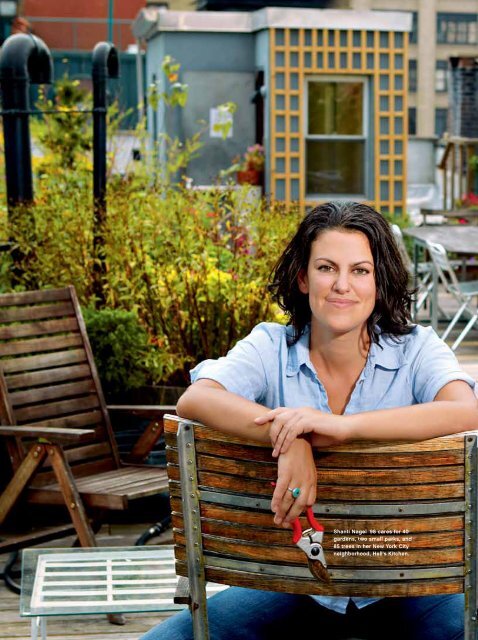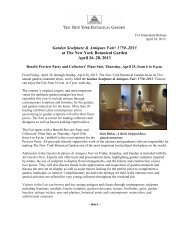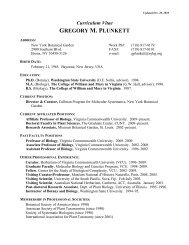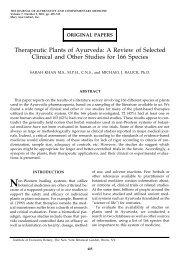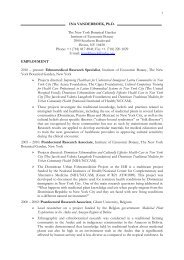Shanti Nagel - New York Botanical Garden
Shanti Nagel - New York Botanical Garden
Shanti Nagel - New York Botanical Garden
You also want an ePaper? Increase the reach of your titles
YUMPU automatically turns print PDFs into web optimized ePapers that Google loves.
emma<br />
<strong>Shanti</strong> <strong>Nagel</strong> ’98 cares for 40<br />
gardens, two small parks, and<br />
85 trees in her <strong>New</strong> <strong>York</strong> City<br />
neighborhood, Hell’s Kitchen.
photo: Bob Handelman<br />
BY LIZZIE STARK<br />
<strong>Shanti</strong> <strong>Nagel</strong> ’98<br />
cultivates community,<br />
one garden at a time<br />
h~me<br />
at<br />
in<br />
hell’s kitchen<br />
“It’s so beautiful out here,” a middle-aged woman<br />
yells from a rooftop garden two stories above <strong>Shanti</strong><br />
<strong>Nagel</strong> ’98. “It’s getting there,” answers <strong>Nagel</strong>, 31, who<br />
created and maintains the lush sanctuary.<br />
Fall 2011<br />
15
16<br />
Down where we’re sitting, in a courtyard<br />
garden that <strong>Nagel</strong> also designed, she explains<br />
that this is the best part of her job. “e<br />
payback is awesome,” she says. is aordable<br />
housing building was renovated just two years ago, and<br />
a lot of older women live here,” she tells me. “ey come out<br />
and talk to me about plants all the time. And they love watching<br />
our progress.”<br />
<strong>Nagel</strong> lives and works in the Hell’s Kitchen neighborhood of<br />
<strong>New</strong> <strong>York</strong> City, where she is on a mission to improve the neighborhood<br />
one garden at a time. She is ever-present on the streets,<br />
the sidewalks, and even up on the roofs as she chisels more<br />
precious green space into a vast concrete desert, transforming<br />
the environment outside of buildings that house low-income<br />
residents, some of whom are formerly homeless. <strong>Nagel</strong> also lives<br />
in one of the buildings where she works, which makes her job<br />
much more than a job; it’s also her home.<br />
e woman on the roof points at a squirrel down in the<br />
courtyard, amazed to nd a real animal in a garden boxed in by<br />
buildings. “is little guy. He’s trouble,” says <strong>Nagel</strong>. “He’s eating<br />
everything. He’s digging everything up.” She tosses an empty<br />
paper cup at him and he doesn’t inch. “And he’s not afraid of<br />
anything!” she laughs. e squirrel scampers up an ornamental<br />
bush and begins eating the berries. Even the squirrels love what<br />
<strong>Nagel</strong> has done to this property!<br />
<strong>Nagel</strong> works for the Clinton Housing Development<br />
Company (CHDC), a <strong>New</strong> <strong>York</strong> City housing association that<br />
manages about 60 buildings for the city, transforming them<br />
from dilapidated derelicts into aordable housing with green<br />
space. Many of the CHDC’s buildings are located in Hell’s<br />
Kitchen, also called Clinton, a large, diverse neighborhood on<br />
the west side of Manhattan, stretching from 34th Street to 59th<br />
Street and from 8th Avenue over to the Hudson River. e<br />
neighborhood contains commercial and residential space and<br />
houses a diverse range of people—from actors and other theater<br />
people who commute to the nearby theater district, to yuppies,<br />
to populations from the “old days” as immortalized in the<br />
musical West Side Story, which was set in this neighborhood.<br />
e CDHC’s buildings contain about 750 apartments and<br />
house more than 1,000 people of varying income levels, including<br />
some formerly homeless people and families. In addition,<br />
many sta members, including <strong>Nagel</strong>, live in these buildings.<br />
For that reason, <strong>Nagel</strong> approached this job—managing<br />
green space in the buildings—with caution. She worked at the<br />
CHDC for a couple months before moving into an apartment<br />
in one of the buildings because she wanted to be certain she<br />
liked the job and the environment. “My home is very precious<br />
to me,” she said, “and to put my home on the line for a job—<br />
I had to be very sure I wanted to be here.” at was three<br />
years ago.<br />
emma<br />
Almost all of the CHDC’s<br />
buildings have green space that<br />
<strong>Nagel</strong> handles. Sometimes, it’s<br />
just a touch—a few window<br />
boxes out front, or a “tree<br />
pit”—a street tree surrounded<br />
by plants and rimmed with<br />
wrought-iron edging. Other<br />
times, it’s a rooftop garden,<br />
a backyard, or a courtyard<br />
garden. In total, <strong>Nagel</strong> cares<br />
for some 40 gardens, plus two<br />
small parks, and 85 street trees<br />
with their surrounding tree<br />
pits. It’s a big job, but one<br />
that is integral to the way the<br />
CHDC approaches its buildings.<br />
According to <strong>Nagel</strong>’s<br />
boss, Joe Restuccia, the executive<br />
director of the nonprot,<br />
green space is “not a luxury,”<br />
even when it comes to aordable<br />
housing. “We don’t build<br />
barns; we build homes, a place<br />
to live,” he said.<br />
As it turns out, green space<br />
has a real impact on citydwellers.<br />
Studies have shown<br />
that areas with green space<br />
have less property and violent<br />
crime and more healthy social<br />
interactions among inhabitants,<br />
perhaps because greenery<br />
alleviates stress and anxiety,<br />
which are precursors to crime,<br />
and because people gather in<br />
green space, which puts more<br />
eyes on the street. Green space<br />
isn’t a nicety, it’s something<br />
that humans need to feel at<br />
home and safe.<br />
Certainly living in a<br />
CDHC building changes the<br />
nature of <strong>Nagel</strong>’s job. For one<br />
thing, she says, “You have a<br />
dierent concern for the tenants<br />
because they’re not just<br />
clients; they’re your neighbors<br />
and they’re people you live<br />
next to all the time and see on<br />
the street.” Employee concerns<br />
and tenant concerns can be<br />
one and the same.<br />
“I think one of the interesting<br />
things about living in<br />
one of these buildings in the<br />
middle of Manhattan is that<br />
you live with tenants who are<br />
real people,” she says. “ey’re<br />
people with kids, they’re<br />
families, they’re older people,<br />
they’re normal working people.<br />
e building next to us is a<br />
super-fancy glass castle, and<br />
the people coming out of there<br />
look very dierent. I’d much<br />
rather live with the people in<br />
my building.”<br />
Having sta live in the<br />
department’s buildings also<br />
means more eyeballs on everything,<br />
including the gardens.<br />
<strong>Nagel</strong> pointed out that the<br />
super of the building we’re in<br />
drinks his coee in the garden,<br />
and “he calls me up and tells<br />
me when anything is wrong or<br />
when anything is right.” e<br />
supers help take care of green<br />
space, primarily by watering<br />
it. “I would be nothing without<br />
them,” <strong>Nagel</strong> says. But<br />
the supers benet from the<br />
arrangement as well, because<br />
residents and people on the<br />
street praise the plants. “ey<br />
get all that feedback, especially<br />
the ones that live on the premises—they<br />
get the plant bug,”<br />
<strong>Nagel</strong> explained.<br />
It’s no mystery why the<br />
supers like <strong>Nagel</strong> either. Of<br />
course, she’s young and attractive,<br />
which doesn’t hurt, but<br />
more than this, her enthusiasm<br />
for her work is evident, and<br />
not just its botanical component—she<br />
loves working with<br />
people. Her re for community<br />
organizing is part of why<br />
Restuccia hired her, he said.<br />
As <strong>Nagel</strong> walks me through<br />
the neighborhood, past tree<br />
pits, parks, and window boxes,
she talks about the plants, the<br />
people, and the history of this<br />
neighborhood.<br />
We tromp up ve ights of<br />
stairs—this is how she stays in<br />
shape, she says—to a rooftop<br />
garden lined with pots exploding<br />
with greenery. is is her<br />
boss’s building, she explains,<br />
and it’s not easy to keep rooftop<br />
gardens so lush. Watering<br />
is a challenge in the city, where<br />
hoses often live in basements.<br />
<strong>Nagel</strong>’s boss learned this rsthand.<br />
For years, he kept up<br />
this garden with an elderly<br />
neighbor woman who spent<br />
hours each day lugging watering<br />
cans to the roof. When she<br />
passed away, many of his plants<br />
oundered. Now <strong>Nagel</strong> has<br />
introduced him to the marvels<br />
of irrigation—there are small<br />
metal rings in each of the pots,<br />
which are hooked up to a central<br />
water supply— and all this<br />
resulting greenery has made<br />
him a convert.<br />
Restuccia and <strong>Nagel</strong> share<br />
a gardening aesthetic, favoring<br />
gardens that look wild<br />
and natural instead of rigidly<br />
organized. Restuccia came up<br />
with the tree pit concept, while<br />
<strong>Nagel</strong> designed and executed<br />
it. Forget dull rows of begonias<br />
or impatiens. <strong>Nagel</strong>’s tree pits<br />
look wild and biodiverse, full<br />
of reedy owers, lush variegated<br />
leaves, and other plants. e<br />
CHDC’s work is spreading like<br />
a beautifully invasive vine, and<br />
envious neighboring buildings<br />
have approached Restuccia<br />
and <strong>Nagel</strong> for advice on how<br />
to edge their tree pits in iron<br />
and ll them with plantings.<br />
It’s not easy to nd the<br />
right plants to grow in the<br />
city. “When you get a gardening<br />
book they don’t tell you<br />
what plant can handle hours<br />
of heavy bus exhaust,” says<br />
<strong>Nagel</strong>, or hundreds of dogs<br />
peeing on it each day. “ese<br />
are the kind of environmental<br />
issues that we deal with here<br />
in the city,” she added. “And<br />
we’re really homing in on<br />
the plants that can handle it.<br />
Some of them are a surprise.”<br />
Like Japanese anemone,<br />
which tolerates hours of<br />
bumper-to-bumper exhaust<br />
each day, since she’s planted<br />
it on a block that leads to the<br />
Lincoln Tunnel.<br />
Oftentimes, <strong>Nagel</strong> tries<br />
to sneak an edible—like a<br />
potato or Swiss chard—into<br />
plantings, just to generate<br />
conversation. While working<br />
on an edible food project for<br />
<strong>New</strong> <strong>York</strong> University a couple<br />
of years ago, she noticed that<br />
while owers provoke aesthetic<br />
reactions—“Oh, pretty<br />
owers!”—vegetables in the<br />
city induce a whole conversation.<br />
People, particularly older<br />
ones, dredge up memories of<br />
the farms from their youth,<br />
she says, and everyone asks<br />
questions like, “Who’s going<br />
to eat vegetables?” or “What<br />
happens if someone steals<br />
the vegetables?”<br />
“ My home is very precious to me,<br />
and to put my home on the line<br />
for a job—I had to be very<br />
sure I wanted to be here.”<br />
Vegetables are <strong>Nagel</strong>’s<br />
rst love. She grew up outside<br />
Saratoga Springs on her<br />
family’s 10 acres. Her parents,<br />
whom she describes as<br />
“incredibly skilled vegetable<br />
gardeners,” cultivated food<br />
on about half the land. Each<br />
weekend, she and her siblings<br />
had to work in the garden for<br />
a few hours. As she got older,<br />
working in the garden stopped<br />
being a chore, and she stayed<br />
and weeded and pruned with<br />
her parents long after she’d<br />
nished the mandatory weeding.<br />
After graduating from<br />
Emma Willard, she spent<br />
almost a decade farming,<br />
then studied at the <strong>New</strong> <strong>York</strong><br />
<strong>Botanical</strong> <strong>Garden</strong> School of<br />
Professional Horticulture for<br />
a few years before joining the<br />
CHDC’s sta.<br />
Now, even though her<br />
schedule is hectic thanks to<br />
the intense logistics of keeping<br />
up so many gardens in <strong>New</strong><br />
<strong>York</strong> City, <strong>Nagel</strong> still nds<br />
time to grow food. Across<br />
the street from the CHDC’s<br />
oce, at Metro Baptist<br />
Church, she’s organized a<br />
rooftop vegetable garden.<br />
It was hard to carry all the<br />
materials up to the roof of this<br />
ve-story building since there’s<br />
no elevator, but church members<br />
and volunteers helped<br />
haul soil and baby pools to<br />
use as containers. e produce<br />
from this garden—tomatoes,<br />
basil, cucumbers, zucchini,<br />
peppers, beans, peas, and<br />
more—goes to a local food<br />
pantry. Downstairs, inside the<br />
church, there is produce available,<br />
too, though it wasn’t<br />
grown on the roof. <strong>Nagel</strong> has<br />
organized a local CSA share.<br />
(CSA stands for communitysupported<br />
agriculture and<br />
allows people to buy vegetables<br />
directly from the farmer.)<br />
Eventually, <strong>Nagel</strong> hopes to<br />
nd grant money so that the<br />
local food pantry can take a<br />
share of the crops. And while<br />
altruism is part of her motive,<br />
so too is her love of farmgrown<br />
vegetables. She wanted<br />
a CSA that was convenient to<br />
her, and this one’s just across<br />
from her oce.<br />
For the time being, <strong>Nagel</strong><br />
says, <strong>New</strong> <strong>York</strong> City is her<br />
home. She’s got a local CSA,<br />
a bevy of close girlfriends who<br />
date from her time at Emma<br />
Willard, and plenty of room<br />
to garden and, through gardening,<br />
to create community<br />
in her neighborhood. Living<br />
where she works has transformed<br />
the experience of <strong>New</strong><br />
<strong>York</strong> for her. Unlike many<br />
<strong>New</strong> <strong>York</strong>ers, she knows her<br />
neighbors and her neighbors<br />
know her. “I can walk around<br />
Hell’s Kitchen,” she says, “it<br />
can be 42nd Street and 8th<br />
Avenue (near Times Square),<br />
super-urban, total <strong>New</strong> <strong>York</strong>;<br />
I can walk around those<br />
streets and people stop me<br />
and recognize me and talk to<br />
me about plants.”<br />
Fall 2011<br />
17


